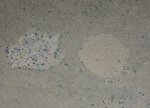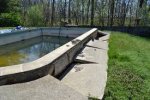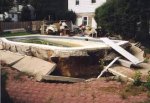Hello, hoping for some help.
To summarize: after draining pool, surface delaminated/bubbled in spots BUT I do not see concrete. Can the pool be refilled for a few more seasons until have $$ for replastering? See pic.
Details
- pool was drained to replace water and few delaminated spots patched with "hydraulic cement"
- After some rain more spots delaminated or bubbled (likely other spots are weak but not noticed yet)
- plaster is old, maybe >15yrs
- Each spot, cannot see concrete, so seems there's still a good barrier.
Since funds are limited, can the pool be refilled to be resurface at a later date? Cheapest and best option... looks are minor concern.
- Should bubbled spots be filled?
- How about painting the surface instead of plaster?
**In the pic, can see delaminated spot and patch spot using hydraulic cement**
Thanks for any help!
To summarize: after draining pool, surface delaminated/bubbled in spots BUT I do not see concrete. Can the pool be refilled for a few more seasons until have $$ for replastering? See pic.
Details
- pool was drained to replace water and few delaminated spots patched with "hydraulic cement"
- After some rain more spots delaminated or bubbled (likely other spots are weak but not noticed yet)
- plaster is old, maybe >15yrs
- Each spot, cannot see concrete, so seems there's still a good barrier.
Since funds are limited, can the pool be refilled to be resurface at a later date? Cheapest and best option... looks are minor concern.
- Should bubbled spots be filled?
- How about painting the surface instead of plaster?
**In the pic, can see delaminated spot and patch spot using hydraulic cement**
Thanks for any help!





